架构大合集,轻松应对工作需求(中)
Posted 初一十五啊
tags:
篇首语:本文由小常识网(cha138.com)小编为大家整理,主要介绍了架构大合集,轻松应对工作需求(中)相关的知识,希望对你有一定的参考价值。
前言
本文讲述:
- 数据结构和算法,23种设计模式,
- OKhttp,Retrofit,
- Glide,
- Dagger2,
- MVP,MVC,MVVM,MVI,
- Jetpack Room,
可能字数限制会分为2-3篇讲述😂
今天星期一,星期一,星期一😑
关注公众号:初一十五a
解锁 《Android十大板块文档》,让学习更贴近未来实战。已形成PDF版
内容如下:
1.2022最新Android11位大厂面试专题,128道附答案
2.音视频大合集,从初中高到面试应有尽有
3.Android车载应用大合集,从零开始一起学
4.性能优化大合集,告别优化烦恼
5.Framework大合集,从里到外分析的明明白白
6.Flutter大合集,进阶Flutter高级工程师
7.compose大合集,拥抱新技术
8.Jetpack大合集,全家桶一次吃个够
9.架构大合集,轻松应对工作需求
10.Android基础篇大合集,根基稳固高楼平地起
整理不易,关注一下吧。开始进入正题,ღ( ´・ᴗ・` ) 🤔
三丶图片加载
1.Glide
1.1.基本使用流程
Glide最基本的使用流程就是下面这行代码,其它所有扩展的额外功能都是以其建造者链式调用的基础上增加的。
GlideApp.with(context).load(url).into(iv);
其中的GlideApp是注解处理器自动生成的,要使用GlideApp,必须先配置应用的AppGlideModule模块,里面可以为空配置,也可以根据实际情况添加指定配置。
@GlideModule
public class MyAppGlideModule extends AppGlideModule
@Override
public void applyOptions(Context context, GlideBuilder builder)
// 实际使用中根据情况可以添加如下配置
<!--builder.setDefaultRequestOptions(new RequestOptions().format(DecodeFormat.PREFER_RGB_565));-->
<!--int memoryCacheSizeBytes = 1024 * 1024 * 20;-->
<!--builder.setMemoryCache(new LruResourceCache(memoryCacheSizeBytes));-->
<!--int bitmapPoolSizeBytes = 1024 * 1024 * 30;-->
<!--builder.setBitmapPool(new LruBitmapPool(bitmapPoolSizeBytes));-->
<!--int diskCacheSizeBytes = 1024 * 1024 * 100;-->
<!--builder.setDiskCache(new InternalCacheDiskCacheFactory(context, diskCacheSizeBytes));-->
接下来,本文将针对Glide的最新源码版本V4.8.0对Glide加载网络图片的流程进行详细地分析与讲解,力争做到让读者朋友们知其然也知其所以然。
1.2.GlideApp.with(context)源码详解
首先,用这份Glide框架图让我们对Glide的总体框架有一个初步的了解。
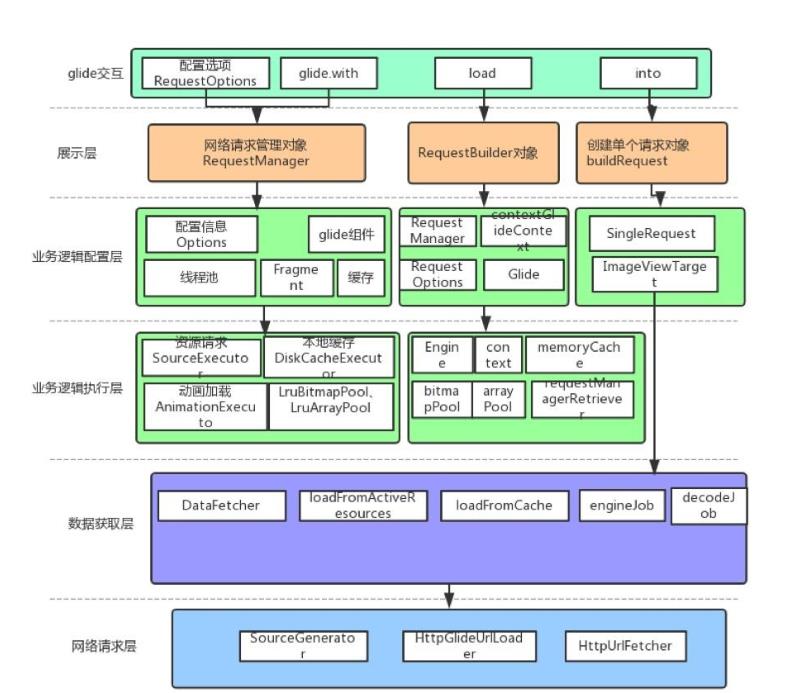
从GlideApp.with这行代码开始,内部主线执行流程如下。
GlideApp#with
return (GlideRequests) Glide.with(context);
Glide#with
return getRetriever(context).get(context);
return Glide.get(context).getRequestManagerRetriever();
// 外部使用了双重检锁的同步方式确保同一时刻只执一次Glide的初始化
checkAndInitializeGlide(context);
initializeGlide(context);
// 最终执行到Glide的另一个重载方法
initializeGlide(context, new GlideBuilder());
@SuppressWarnings("deprecation")
private static void initializeGlide(@NonNull Context context, @NonNull GlideBuilder builder)
Context applicationContext = context.getApplicationContext();
// 1、获取前面应用中带注解的GlideModule
GeneratedAppGlideModule annotationGeneratedModule = getAnnotationGeneratedGlideModules();
// 2、如果GlideModule为空或者可配置manifest里面的标志为true,则获取manifest里面
// 配置的GlideModule模块(manifestModules)。
List<com.bumptech.glide.module.GlideModule> manifestModules = Collections.emptyList();
if (annotationGeneratedModule == null || annotationGeneratedModule.isManifestParsingEnabled( ))
manifestModules = new ManifestParser(applicationContext).parse();
...
RequestManagerRetriever.RequestManagerFactory factory =
annotationGeneratedModule != null
? annotationGeneratedModule.getRequestManag erFactory() : null;
builder.setRequestManagerFactory(factory);
for (com.bumptech.glide.module.GlideModule module : manifestModules)
module.applyOptions(applicationContext, builder);
if (annotationGeneratedModule != null)
annotationGeneratedModule.applyOptions(applicatio nContext, builder);
// 3、初始化各种配置信息
Glide glide = builder.build(applicationContext);
// 4、把manifestModules以及annotationGeneratedModule里面的配置信息放到builder
// 里面(applyOptions)替换glide默认组件(registerComponents)
for (com.bumptech.glide.module.GlideModule module : manifestModules)
module.registerComponents(applicationContext, glide, glide.registry);
if (annotationGeneratedModule != null)
annotationGeneratedModule.registerComponents(appl icationContext, glide, glide.registry);
applicationContext.registerComponentCallbacks(glide );
Glide.glide = glide;
GlideBuilder#build
@NonNull
Glide build(@NonNull Context context)
// 创建请求图片线程池sourceExecutor
if (sourceExecutor == null)
sourceExecutor = GlideExecutor.newSourceExecutor();
// 创建硬盘缓存线程池diskCacheExecutor
if (diskCacheExecutor == null)
diskCacheExecutor = GlideExecutor.newDiskCacheExecutor();
// 创建动画线程池animationExecutor
if (animationExecutor == null)
animationExecutor = GlideExecutor.newAnimationExecutor();
if (memorySizeCalculator == null)
memorySizeCalculator = new MemorySizeCalculator.Builder(context).build();
if (connectivityMonitorFactory == null)
connectivityMonitorFactory = new DefaultConnectivityMonitorFactory();
if (bitmapPool == null)
// 依据设备的屏幕密度和尺寸设置各种pool的size
int size = memorySizeCalculator.getBitmapPoolSize();
if (size > 0)
// 创建图片线程池LruBitmapPool,缓存所有被释放的bitmap
// 缓存策略在API大于19时,为SizeConfigStrategy,小于为AttributeStrategy。
// 其中SizeConfigStrategy是以bitmap的size和config为key,value为bitmap的HashMap
bitmapPool = new LruBitmapPool(size);
else
bitmapPool = new BitmapPoolAdapter();
// 创建对象数组缓存池LruArrayPool,默认4M
if (arrayPool == null)
arrayPool = new LruArrayPool(memorySizeCalculator.getArrayPoolSiz eInBytes());
// 创建LruResourceCache,内存缓存
if (memoryCache == null)
memoryCache = new LruResourceCache(memorySizeCalculator.getMemoryCa cheSize());
if (diskCacheFactory == null)
diskCacheFactory = new InternalCacheDiskCacheFactory(context);
// 创建任务和资源管理引擎(线程池,内存缓存和硬盘缓存对象)
if (engine == null)
engine =
new Engine(
memoryCache,
diskCacheFactory,
diskCacheExecutor,
sourceExecutor,
GlideExecutor.newUnlimitedSourceExecutor( ),
GlideExecutor.newAnimationExecutor(),
isActiveResourceRetentionAllowed);
RequestManagerRetriever requestManagerRetriever =
new RequestManagerRetriever(requestManagerFactory);
return new Glide(
context,
engine,
memoryCache,
bitmapPool,
arrayPool,
requestManagerRetriever,
connectivityMonitorFactory,
logLevel,
defaultRequestOptions.lock(),
defaultTransitionOptions);
Glide#Glide构造方法
Glide(...)
...
// 注册管理任务执行对象的类(Registry)
// Registry是一个工厂,而其中所有注册的对象都是一个工厂员工,当任务分发时,
// 根据当前任务的性质,分发给相应员工进行处理
registry = new Registry();
...
// 这里大概有60余次的append或register员工组件(解析器、编解码器、工厂类、转码类等等组件)
registry
.append(ByteBuffer.class, new ByteBufferEncoder())
.append(InputStream.class, new StreamEncoder(arrayPool))
// 根据给定子类产出对应类型的target(BitmapImageViewTarget / DrawableImageViewTarget)
ImageViewTargetFactory imageViewTargetFactory = new ImageViewTargetFactory();
glideContext =
new GlideContext(
context,
arrayPool,
registry,
imageViewTargetFactory,
defaultRequestOptions,
defaultTransitionOptions,
engine,
logLevel);
RequestManagerRetriever#get
@NonNull
public RequestManager get(@NonNull Context context)
if (context == null)
throw new IllegalArgumentException("You cannot start a load on a null Context");
else if (Util.isOnMainThread() && !(context instanceof Application))
// 如果当前线程是主线程且context不是Application走相应的get重载方法
if (context instanceof FragmentActivity)
return get((FragmentActivity) context);
else if (context instanceof Activity)
return get((Activity) context);
else if (context instanceof ContextWrapper)
return get(((ContextWrapper) context).getBaseContext());
// 否则直接将请求与ApplicationLifecycle关联
return getApplicationManager(context);
这里总结一下,对于当前传入的context是application或当前线程是子线程时,请求的生命周期和ApplicationLifecycle关联,否则,context是FragmentActivity或Fragment时,在当前组件添加一个SupportFragment(SupportRequestManagerFragment),context是Activity时,在当前组件添加一个Fragment(RequestManagerFragment)。
GlideApp#with小结
-
初始化各式各样的配置信息(包括缓存,请求线程池,大小,图片格式等等)以及glide对象。
-
将glide请求和application/SupportFragment/Fragment的生命周期绑定在一块。
with方法的执行流程

1.3.load(url)源码详解
GlideRequest(RequestManager)#load
return (GlideRequest<Drawable>) super.load(string);
return asDrawable().load(string);
// 1、asDrawable部分
return (GlideRequest<Drawable>) super.asDrawable();
return as(Drawable.class);
// 最终返回了一个GlideRequest(RequestManager的子类)
return new GlideRequest<>(glide, this, resourceClass, context);
// 2、load部分
return (GlideRequest<TranscodeType>) super.load(string);
return loadGeneric(string);
@NonNull
private RequestBuilder<TranscodeType> loadGeneric(@Nullable Object model)
// model则为设置的url
this.model = model;
// 记录url已设置
isModelSet = true;
return this;
可以看到,load这部分的源码很简单,就是给GlideRequest(RequestManager)设置了要请求的mode(url),并记录了url已设置的状态。
load方法的执行流程
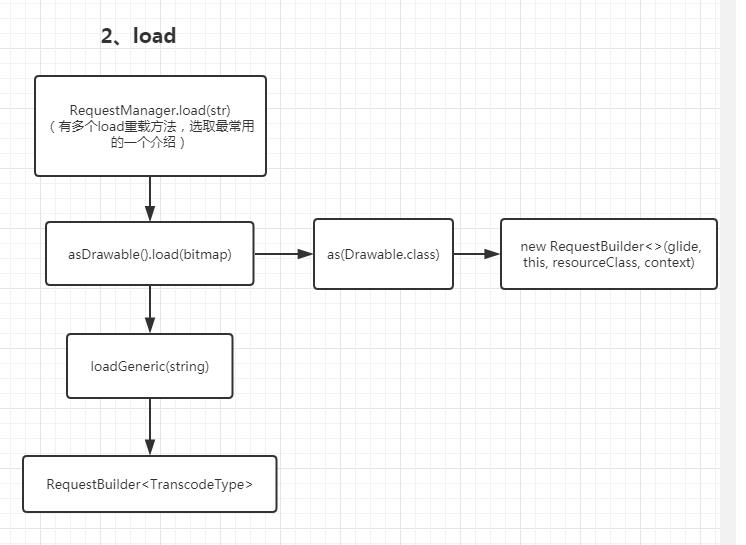
1.4.into(iv)源码详解
真正复杂的地方要开始了。
RequestBuilder.into
@NonNull
public ViewTarget<ImageView, TranscodeType> into(@NonNull ImageView view)
Util.assertMainThread();
Preconditions.checkNotNull(view);
RequestOptions requestOptions = this.requestOptions;
if (!requestOptions.isTransformationSet()
&& requestOptions.isTransformationAllowed()
&& view.getScaleType() != null)
// Clone in this method so that if we use this RequestBuilder to load into a View and then
// into a different target, we don't retain the transformation applied based on the previous
// View's scale type.
switch (view.getScaleType())
// 这个RequestOptions里保存了要设置的scaleType,Glide自身封装了CenterCrop、CenterInside、
// FitCenter、CenterInside四种规格。
case CENTER_CROP:
requestOptions = requestOptions.clone().optionalCenterCrop();
break;
case CENTER_INSIDE:
requestOptions = requestOptions.clone().optionalCenterInside() ;
break;
case FIT_CENTER:
case FIT_START:
case FIT_END:
requestOptions = requestOptions.clone().optionalFitCenter();
break;
case FIT_XY:
requestOptions = requestOptions.clone().optionalCenterInside() ;
break;
case CENTER:
case MATRIX:
default:
// Do nothing.
// 注意,这个transcodeClass是指的drawable或bitmap
return into(
glideContext.buildImageViewTarget(view, transcodeClass),
/*targetListener=*/ null,
requestOptions);
GlideContext#buildImageViewTarget
return imageViewTargetFactory.buildTarget(imageView, transcodeClass);
ImageViewTargetFactory#buildTarget
@NonNull
@SuppressWarnings("unchecked")
public <Z> ViewTarget<ImageView, Z> buildTarget(@NonNull ImageView view,
@NonNull Class<Z> clazz)
// 返回展示Bimtap/Drawable资源的目标对象
if (Bitmap.class.equals(clazz))
return (ViewTarget<ImageView, Z>) new BitmapImageViewTarget(view);
else if (Drawable.class.isAssignableFrom(clazz))
return (ViewTarget<ImageView, Z>) new DrawableImageViewTarget(view);
else
throw new IllegalArgumentException(
"Unhandled class: " + clazz + ", try .as*(Class).transcode(ResourceTranscoder)");
可以看到,Glide内部只维护了两种target,一种是BitmapImageViewTarget,另一种则是DrawableImageViewTarget,接下来继续深入。
RequestBuilder#into
private <Y extends Target<TranscodeType>> Y into(
@NonNull Y target,
@Nullable RequestListener<TranscodeType> targetListener,
@NonNull RequestOptions options)
Util.assertMainThread();
Preconditions.checkNotNull(target);
if (!isModelSet)
throw new IllegalArgumentException("You must call #load() before calling #into()");
options = options.autoClone();
// 分析1.建立请求
Request request = buildRequest(target, targetListener, options);
Request previous = target.getRequest();
if (request.isEquivalentTo(previous)
&& !isSkipMemoryCacheWithCompletePreviousReques t(options, previous))
request.recycle();
// If the request is completed, beginning again will ensure the result is re-delivered,
// triggering RequestListeners and Targets. If the request is failed, beginning again will
// restart the request, giving it another chance to complete. If the request is already
// running, we can let it continue running without interruption.
if (!Preconditions.checkNotNull(previous).isRunni ng())
// Use the previous request rather than the new one to allow for optimizations like skipping
// setting placeholders, tracking and un-tracking Targets, and obtaining View dimensions
// that are done in the individual Request.
previous.begin();
return target;
requestManager.clear(target);
target.setRequest(request);
// 分析2.真正追踪请求的地方
requestManager.track(target, request);
return target;
// 分析1
private Request buildRequest(
Target<TranscodeType> target,
@Nullable RequestListener<TranscodeType> targetListener,
RequestOptions requestOptions)
return buildRequestRecursive(
target,
targetListener,
/*parentCoordinator=*/ null,
transitionOptions,
requestOptions.getPriority(),
requestOptions.getOverrideWidth(),
requestOptions.getOverrideHeight(),
requestOptions);
// 分析1
private Request buildRequestRecursive(
Target<TranscodeType> target,
@Nullable RequestListener<TranscodeType> targetListener,
@Nullable RequestCoordinator parentCoordinator,
TransitionOptions<?, ? super TranscodeType> transitionOptions,
Priority priority,
int overrideWidth,
int overrideHeight,
RequestOptions requestOptions)
// Build the ErrorRequestCoordinator first if necessary so we can update parentCoordinator.
ErrorRequestCoordinator errorRequestCoordinator = null;
if (errorBuilder != null)
// 创建errorRequestCoordinator(异常处理对象)
errorRequestCoordinator = new ErrorRequestCoordinator(parentCoordinator);
parentCoordinator = errorRequestCoordinator;
// 递归建立缩略图请求
Request mainRequest =
buildThumbnailRequestRecursive(
target,
targetListener,
parentCoordinator,
transitionOptions,
priority,
overrideWidth,
overrideHeight,
requestOptions);
if (errorRequestCoordinator == null)
return mainRequest;
...
Request errorRequest = errorBuilder.buildRequestRecursive(
target,
targetListener,
errorRequestCoordinator,
errorBuilder.transitionOptions,
errorBuilder.requestOptions.getPriority(),
errorOverrideWidth,
errorOverrideHeight,
errorBuilder.requestOptions);
errorRequestCoordinator.setRequests(mainRequest, errorRequest);
return errorRequestCoordinator;
// 分析1
private Request buildThumbnailRequestRecursive(
Target<TranscodeType> target,
RequestListener<TranscodeType> targetListener,
@Nullable RequestCoordinator parentCoordinator,
TransitionOptions<?, ? super TranscodeType> transitionOptions,
Priority priority,
int overrideWidth,
int overrideHeight,
RequestOptions requestOptions)
if (thumbnailBuilder != null)
// Recursive case: contains a potentially recursive thumbnail request builder.
...
ThumbnailRequestCoordinator coordinator = new ThumbnailRequestCoordinator(parentCoordinator);
// 获取一个正常请求对象
Request fullRequest =
obtainRequest(
target,
targetListener,
requestOptions,
coordinator,
transitionOptions,
priority,
overrideWidth,
overrideHeight);
isThumbnailBuilt = true;
// Recursively generate thumbnail requests.
// 使用递归的方式建立一个缩略图请求对象
Request thumbRequest =
thumbnailBuilder.buildRequestRecursive(
target,
targetListener,
coordinator,
thumbTransitionOptions,
thumbPriority,
thumbOverrideWidth,
thumbOverrideHeight,
thumbnailBuilder.requestOptions);
isThumbnailBuilt = false;
// coordinator(ThumbnailRequestCoordinator)是作为两者的协调者,
// 能够同时加载缩略图和正常的图的请求
coordinator.setRequests(fullRequest, thumbRequest);
return coordinator;
else if (thumbSizeMultiplier != null)
// Base case: thumbnail multiplier generates a thumbnail request, but cannot recurse.
// 当设置了缩略的比例thumbSizeMultiplier(0 ~ 1)时,
// 不需要递归建立缩略图请求
ThumbnailRequestCoordinator coordinator = new ThumbnailRequestCoordinator(parentCoordinator);
Request fullRequest =
obtainRequest(
target,
targetListener,
requestOptions,
coordinator,
transitionOptions,
priority,
overrideWidth,
overrideHeight);
RequestOptions thumbnailOptions = requestOptions.clone()
.sizeMultiplier(thumbSizeMultiplier);
Request thumbnailRequest =
obtainRequest(
target,
targetListener,
thumbnailOptions,
coordinator,
transitionOptions,
getThumbnailPriority(priority),
overrideWidth,
overrideHeight);
coordinator.setRequests(fullRequest, thumbnailRequest);
return coordinator;
else
// Base case: no thumbnail.
// 没有缩略图请求时,直接获取一个正常图请求
return obtainRequest(
target,
targetListener,
requestOptions,
parentCoordinator,
transitionOptions,
priority,
overrideWidth,
overrideHeight);
private Request obtainRequest(
Target<TranscodeType> target,
RequestListener<TranscodeType> targetListener,
RequestOptions requestOptions,
RequestCoordinator requestCoordinator,
TransitionOptions<?, ? super TranscodeType> transitionOptions,
Priority priority,
int overrideWidth,
int overrideHeight)
// 最终实际返回的是一个SingleRequest对象(将制定的资源加载进对应的Target
return SingleRequest.obtain(
context,
glideContext,
model,
transcodeClass,
requestOptions,
overrideWidth,
overrideHeight,
priority,
target,
targetListener,
requestListeners,
requestCoordinator,
glideContext.getEngine(),
transitionOptions.getTransitionFactory());
从上源码分析可知,我们在分析1处的buildRequest()方法里建立了请求,且最多可同时进行缩略图和正常图的请求,最后,调用了requestManager.track(target, request)方法,接着看看track里面做了什么。
RequestManager#track
// 分析2
void track(@NonNull Target<?> target, @NonNull Request request)
// 加入一个target目标集合(Set)
targetTracker.track(target);
requestTracker.runRequest(request);
RequestTracker#runRequest
/**
* Starts tracking the given request.
*/
// 分析2
public void runRequest(@NonNull Request request)
requests.add(request);
if (!isPaused)
// 如果不是暂停状态则开始请求
request.begin();
else
request.clear();
if (Log.isLoggable(TAG, Log.VERBOSE))
Log.v(TAG, "Paused, delaying request");
// 否则清空请求,加入延迟请求队列(为了对这些请求维持一个强引用,使用了ArrayList实现)
pendingRequests.add(request);
SingleRequest#begin
// 分析2
@Override
public void begin()
...
if (model == null)
...
// model(url)为空,回调加载失败
onLoadFailed(new GlideException("Received null model"), logLevel);
return;
if (status == Status.RUNNING)
throw new IllegalArgumentException("Cannot restart a running request");
if (status == Status.COMPLETE)
onResourceReady(resource, DataSource.MEMORY_CACHE);
return;
status = Status.WAITING_FOR_SIZE;
if (Util.isValidDimensions(overrideWidth, overrideHeight))
// 当使用override() API为图片指定了一个固定的宽高时直接执行onSizeReady,
// 最终的核心处理位于onSizeReady
onSizeReady(overrideWidth, overrideHeight);
else
// 根据imageView的宽高算出图片的宽高,最终也会走到onSizeReady
target.getSize(this);
if ((status == Status.RUNNING || status == Status.WAITING_FOR_SIZE)
&& canNotifyStatusChanged())
// 预先加载设置的缩略图
target.onLoadStarted(getPlaceholderDrawable());
if (IS_VERBOSE_LOGGABLE)
logV("finished run method in " + LogTime.getElapsedMillis(startTime));
从requestManager.track(target, request)开始,最终会执行到SingleRequest#begin()方法的onSizeReady,可以猜到(因为后面只做了预加载缩略图的处理),真正的请求就是从这里开始的,咱们进去一探究竟~
SingleRequest#onSizeReady
// 分析2
@Override
public void onSizeReady(int width, int height)
stateVerifier.throwIfRecycled();
...
status = Status.RUNNING;
float sizeMultiplier = requestOptions.getSizeMultiplier();
this.width = maybeApplySizeMultiplier(width, sizeMultiplier);
this.height = maybeApplySizeMultiplier(height, sizeMultiplier);
...
// 根据给定的配置进行加载,engine是一个负责加载、管理活跃和缓存资源的引擎类
loadStatus = engine.load(
glideContext,
model,
requestOptions.getSignature(),
this.width,
this.height,
requestOptions.getResourceClass(),
transcodeClass,
priority,
requestOptions.getDiskCacheStrategy(),
requestOptions.getTransformations(),
requestOptions.isTransformationRequired(),
requestOptions.isScaleOnlyOrNoTransform(),
requestOptions.getOptions(),
requestOptions.isMemoryCacheable(),
requestOptions.getUseUnlimitedSourceGeneratorsP ool(),
requestOptions.getUseAnimationPool(),
requestOptions.getOnlyRetrieveFromCache(),
this);
...
终于看到Engine类了,感觉距离成功不远了,继续~
Engine#load
public <R> LoadStatus load(
GlideContext glideContext,
Object model,
Key signature,
int width,
int height,
Class<?> resourceClass,
Class<R> transcodeClass,
Priority priority,
DiskCacheStrategy diskCacheStrategy,
Map<Class<?>, Transformation<?>> transformations,
boolean isTransformationRequired,
boolean isScaleOnlyOrNoTransform,
Options options,
boolean isMemoryCacheable,
boolean useUnlimitedSourceExecutorPool,
boolean useAnimationPool,
boolean onlyRetrieveFromCache,
ResourceCallback cb)
...
// 先从弱引用中查找,如果有的话回调onResourceReady并直接返回
EngineResource<?> active = loadFromActiveResources(key, isMemoryCacheable);
if (active != null)
cb.onResourceReady(active, DataSource.MEMORY_CACHE);
if (VERBOSE_IS_LOGGABLE)
logWithTimeAndKey("Loaded resource from active resources", startTime, key);
return null;
// 没有再从内存中查找,有的话会取出并放到ActiveResources(内部维护的弱引用缓存map)里面
EngineResource<?> cached = loadFromCache(key, isMemoryCacheable);
if (cached != null)
cb.onResourceReady(cached, DataSource.MEMORY_CACHE);
if (VERBOSE_IS_LOGGABLE)
logWithTimeAndKey("Loaded resource from cache", startTime, key);
return null;
EngineJob<?> current = jobs.get(key, onlyRetrieveFromCache);
if (current != null)
current.addCallback(cb);
if (VERBOSE_IS_LOGGABLE)
logWithTimeAndKey("Added to existing load", startTime, key);
return new LoadStatus(cb, current);
// 如果内存中没有,则创建engineJob(decodejob的回调类,管理下载过程以及状态)
EngineJob<R> engineJob =
engineJobFactory.build(
key,
isMemoryCacheable,
useUnlimitedSourceExecutorPool,
useAnimationPool,
onlyRetrieveFromCache);
// 创建解析工作对象
DecodeJob<R> decodeJob =
decodeJobFactory.build(
glideContext,
model,
key,
signature,
width,
height,
resourceClass,
transcodeClass,
priority,
diskCacheStrategy,
transformations,
isTransformationRequired,
isScaleOnlyOrNoTransform,
onlyRetrieveFromCache,
options,
engineJob);
// 放在Jobs内部维护的HashMap中
jobs.put(key, engineJob);
// 关注点8 后面分析会用到
// 注册ResourceCallback接口
engineJob.addCallback(cb);
// 内部开启线程去请求
engineJob.start(decodeJob);
if (VERBOSE_IS_LOGGABLE)
logWithTimeAndKey("Started new load", startTime, key);
return new LoadStatus(cb, engineJob);
public void start(DecodeJob<R> decodeJob)
this.decodeJob = decodeJob;
// willDecodeFromCache方法内部根据不同的阶段stage,如果是RESOURCE_CACHE/DATA_CACHE则返回true,使用diskCacheExecutor,否则调用getActiveSourceExecutor,内部会根据相应的条件返回sourceUnlimitedExecutor/animationExecutor/sourceExecutor
GlideExecutor executor =
decodeJob.willDecodeFromCache()
? diskCacheExecutor
: getActiveSourceExecutor();
executor.execute(decodeJob);
可以看到,最终Engine(引擎)类内部会执行到自身的start方法,它会根据不同的配置采用不同的线程池使用diskCacheExecutor/sourceUnlimitedExecutor/animationExecutor/sourceExecutor来执行最终的解码任务decodeJob。
DecodeJob#run
runWrapped();
private void runWrapped()
switch (runReason)
case INITIALIZE:
stage = getNextStage(Stage.INITIALIZE);
// 关注点1
currentGenerator = getNextGenerator();
// 关注点2 内部会调用相应Generator的startNext()
runGenerators();
break;
case SWITCH_TO_SOURCE_SERVICE:
runGenerators();
break;
case DECODE_DATA:
// 关注点3 将获取的数据解码成对应的资源
decodeFromRetrievedData();
break;
default:
throw new IllegalStateException("Unrecognized run reason: " + runReason);
// 关注点1,完整情况下,会异步依次生成这里的ResourceCacheGenerator、DataCacheGenerator和SourceGenerator对象,并在之后执行其中的startNext()
private DataFetcherGenerator getNextGenerator()
switch (stage)
case RESOURCE_CACHE:
return new ResourceCacheGenerator(decodeHelper, this);
case DATA_CACHE:
return new DataCacheGenerator(decodeHelper, this);
case SOURCE:
return new SourceGenerator(decodeHelper, this);
case FINISHED:
return null;
default:
throw new IllegalStateException("Unrecognized stage: " + stage);
SourceGenerator#startNext
// 关注点2
@Override
public boolean startNext()
// dataToCache数据不为空的话缓存到硬盘(第一执行该方法是不会调用的)
if (dataToCache != null)
Object data = dataToCache;
dataToCache = null;
cacheData(data);
if (sourceCacheGenerator != null && sourceCacheGenerator.startNext())
return true;
sourceCacheGenerator = null;
loadData = null;
boolean started = false;
while (!started && hasNextModelLoader())
// 关注点4 getLoadData()方法内部会在modelLoaders里面找到ModelLoder对象
// (每个Generator对应一个ModelLoader),
// 并使用modelLoader.buildLoadData方法返回一个loadData列表
loadData = helper.getLoadData().get(loadDataListIndex++);
if (loadData != null
&& (helper.getDiskCacheStrategy().isDataCache able(loadData.fetcher.getDataSource())
|| helper.hasLoadPath(loadData.fetcher.getDat aClass())))
started = true;
// 关注点6 通过loadData对象的fetcher对象(有关注点3的分析可知其实现类为HttpUrlFetcher)的
// loadData方法来获取图片数据
loadData.fetcher.loadData(helper.getPriority(), this);
return started;
DecodeHelper#getLoadData
List<LoadData<?>> getLoadData()
if (!isLoadDataSet)
isLoadDataSet = true;
loadData.clear();
List<ModelLoader<Object, ?>> modelLoaders = glideContext.getRegistry().getModelLoaders(model) ;
//noinspection ForLoopReplaceableByForEach to improve perf
for (int i = 0, size = modelLoaders.size(); i < size; i++)
ModelLoader<Object, ?> modelLoader = modelLoaders.get(i);
// 注意:这里最终是通过HttpGlideUrlLoader的buildLoadData获取到实际的loadData对象
LoadData<?> current =
modelLoader.buildLoadData(model, width, height, options);
if (current != null)
loadData.add(current);
return loadData;
HttpGlideUrlLoader#buildLoadData
@Override
public LoadData<InputStream> buildLoadData(@NonNull GlideUrl model, int width, int height,
@NonNull Options options)
// GlideUrls memoize parsed URLs so caching them saves a few object instantiations and time
// spent parsing urls.
GlideUrl url = model;
if (modelCache != null)
url = modelCache.get(model, 0, 0);
if (url == null)
// 关注点5
modelCache.put(model, 0, 0, model);
url = model;
int timeout = options.get(TIMEOUT);
// 注意,这里创建了一个DataFetcher的实现类HttpUrlFetcher
return new LoadData<>(url, new HttpUrlFetcher(url, timeout));
// 关注点5
public void put(A model, int width, int height, B value)
ModelKey<A> key = ModelKey.get(model, width, height);
// 最终是通过LruCache来缓存对应的值,key是一个ModelKey对象(由model、width、height三个属性组成)
cache.put(key, value);
从这里的分析,我们明白了HttpUrlFetcher实际上就是最终的请求执行者,而且,我们知道了Glide会使用LruCache来对解析后的url来进行缓存,以便后续可以省去解析url的时间。
HttpUrlFetcher#loadData
@Override
public void loadData(@NonNull Priority priority,
@NonNull DataCallback<? super InputStream> callback)
long startTime = LogTime.getLogTime();
try
// 关注点6
// loadDataWithRedirects内部是通过HttpURLConnection网络请求数据
InputStream result = loadDataWithRedirects(glideUrl.toURL(), 0, null, glideUrl.getHeaders());
// 请求成功回调onDataReady()
callback.onDataReady(result);
catch (IOException e)
if (Log.isLoggable(TAG, Log.DEBUG))
Log.d(TAG, "Failed to load data for url", e);
callback.onLoadFailed(e);
finally
if (Log.isLoggable(TAG, Log.VERBOSE))
Log.v(TAG, "Finished http url fetcher fetch in " + LogTime.getElapsedMillis(startTime));
private InputStream loadDataWithRedirects(URL url, int redirects, URL lastUrl,
Map<String, String> headers) throws IOException
...
urlConnection.connect();
// Set the stream so that it's closed in cleanup to avoid resource leaks. See #2352.
stream = urlConnection.getInputStream();
if (isCancelled)
return null;
final int statusCode = urlConnection.getResponseCode();
// 只要是2xx形式的状态码则判断为成功
if (isHttpOk(statusCode))
// 从urlConnection中获取资源流
return getStreamForSuccessfulRequest(urlConnection);
else if (isHttpRedirect(statusCode))
...
// 重定向请求
return loadDataWithRedirects(redirectUrl, redirects + 1, url, headers);
else if (statusCode == INVALID_STATUS_CODE)
throw new HttpException(statusCode);
else
throw new HttpException(urlConnection.getResponseMessage(), statusCode);
private InputStream getStreamForSuccessfulRequest(HttpURLConnection urlConnection)
throws IOException
if (TextUtils.isEmpty(urlConnection.getContentEncoding()))
int contentLength = urlConnection.getContentLength();
stream = ContentLengthInputStream.obtain(urlConnection.getInputStr eam(), contentLength);
else
if (Log.isLoggable(TAG, Log.DEBUG))
Log.d(TAG, "Got non empty content encoding: " + urlConnection.getContentEncoding());
stream = urlConnection.getInputStream();
return stream;
在HttpUrlFetcher#loadData方法的loadDataWithRedirects里面,Glide通过原生的HttpURLConnection进行请求后,并调用getStreamForSuccessfulRequest()方法获取到了最终的图片流。
DecodeJob#run
在我们通过HtttpUrlFetcher的loadData()方法请求得到对应的流之后,我们还必须对流进行处理得到最终我们想要的资源。这里我们回到第10步DecodeJob#run方法的关注点3处,这行代码将会对流进行解码。
decodeFromRetrievedData();
接下来,继续看看他内部的处理。
private void decodeFromRetrievedData()
if (Log.isLoggable(TAG, Log.VERBOSE))
logWithTimeAndKey("Retrieved data", startFetchTime,
"data: " + currentData
+ ", cache key: " + currentSourceKey
+ ", fetcher: " + currentFetcher);
Resource<R> resource = null;
try
// 核心代码
// 从数据中解码得到资源
resource = decodeFromData(currentFetcher, currentData, currentDataSource);
catch (GlideException e)
e.setLoggingDetails(currentAttemptingKey, currentDataSource);
throwables.add(e);
if (resource != null)
// 关注点8
// 编码和发布最终得到的Resource<Bitmap>对象
notifyEncodeAndRelease(resource, currentDataSource);
else
runGenerators();
private <Data> Resource<R> decodeFromData(DataFetcher<?> fetcher, Data data,
DataSource dataSource) throws GlideException
try
if (data == null)
return null;
long startTime = LogTime.getLogTime();
// 核心代码
// 进一步包装了解码方法
Resource<R> result = decodeFromFetcher(data, dataSource);
if (Log.isLoggable(TAG, Log.VERBOSE))
logWithTimeAndKey("Decoded result " + result, startTime);
return result;
finally
fetcher.cleanup();
@SuppressWarnings("unchecked")
private <Data> Resource<R> decodeFromFetcher(Data data, DataSource dataSource)
throws GlideException
LoadPath<Data, ?, R> path = decodeHelper.getLoadPath((Class<Data>) data.getClass());
// 核心代码
// 将解码任务分发给LoadPath
return runLoadPath(data, dataSource, path);
private <Data, ResourceType> Resource<R> runLoadPath(Data data, DataSource dataSource,
LoadPath<Data, ResourceType, R> path) throws GlideException
Options options = getOptionsWithHardwareConfig(dataSource);
// 将数据进一步包装
DataRewinder<Data> rewinder = glideContext.getRegistry().getRewinder(data);
try
// ResourceType in DecodeCallback below is required for compilation to work with gradle.
// 核心代码
// 将解码任务分发给LoadPath
return path.load(
rewinder, options, width, height, new DecodeCallback<ResourceType>(dataSource));
finally
rewinder.cleanup();
LoadPath#load
public Resource<Transcode> load(DataRewinder<Data> rewinder, @NonNull Options options, int width,
int height, DecodePath.DecodeCallback<ResourceType> decodeCallback) throws GlideException
List<Throwable> throwables = Preconditions.checkNotNull(listPool.acquire());
try
// 核心代码
return loadWithExceptionList(rewinder, options, width, height, decodeCallback, throwables);
finally
listPool.release(throwables);
private Resource<Transcode> loadWithExceptionList(DataRewinder<Data> rewinder,
@NonNull Options options,
int width, int height, DecodePath.DecodeCallback<ResourceType> decodeCallback,
List<Throwable> exceptions) throws GlideException
Resource<Transcode> result = null;
//noinspection ForLoopReplaceableByForEach to improve perf
for (int i = 0, size = decodePaths.size(); i < size; i++)
DecodePath<Data, ResourceType, Transcode> path = decodePaths.get(i);
try
// 核心代码
// 将解码任务又进一步分发给DecodePath的decode方法去解码
result = path.decode(rewinder, width, height, options, decodeCallback);
catch (GlideException e)
exceptions.add(e);
if (result != null)
break;
if (result == null)
throw new GlideException(failureMessage, new ArrayList<>(exceptions));
return result;
DecodePath#decode
public Resource<Transcode> decode(DataRewinder<DataType> rewinder, int width, int height,
@NonNull Options options, DecodeCallback<ResourceType> callback) throws GlideException
// 核心代码
// 继续调用DecodePath的decodeResource方法去解析出数据
Resource<ResourceType> decoded = decodeResource(rewinder, width, height, options);
Resource<ResourceType> transformed = callback.onResourceDecoded(decoded);
return transcoder.transcode(transformed, options);
@NonNull
private Resource<ResourceType> decodeResource(DataRewinder<DataType> rewinder, int width,
int height, @NonNull Options options) throws GlideException
List<Throwable> exceptions = Preconditions.checkNotNull(listPool.acquire());
try
// 核心代码
return decodeResourceWithList(rewinder, width, height, options, exceptions);
finally
listPool.release(exceptions);
@NonNull
private Resource<ResourceType> decodeResourceWithList(DataRewinder<DataType> rewinder, int width,
int height, @NonNull Options options, List<Throwable> exceptions) throws GlideException
Resource<ResourceType> result = null;
//noinspection ForLoopReplaceableByForEach to improve perf
for (int i = 0, size = decoders.size(); i < size; i++)
ResourceDecoder<DataType, ResourceType> decoder = decoders.get(i);
try
DataType data = rewinder.rewindAndGet();
if (decoder.handles(data, options))
// 获取包装的数据
data = rewinder.rewindAndGet();
// 核心代码
// 根据DataType和ResourceType的类型分发给不同的解码器Decoder
result = decoder.decode(data, width, height, options);
catch (IOException | RuntimeException | OutOfMemoryError e)
if (Log.isLoggable(TAG, Log.VERBOSE))
Log.v(TAG, "Failed to decode data for " + decoder, e);
exceptions.add(e);
if (result != null)
break;
if (result == null)
throw new GlideException(failureMessage, new ArrayList<>(exceptions));
return result;
可以看到,经过一连串的嵌套调用,最终执行到了decoder.decode()这行代码,decode是一个ResourceDecoder<DataType, ResourceType>接口(资源解码器),根据不同的DataType和ResourceType它会有不同的实现类,这里的实现类是ByteBufferBitmapDecoder,接下来让我们来看看这个解码器内部的解码流程。
ByteBufferBitmapDecoder#decode
/**
* Decodes @link android.graphics.Bitmap Bitmaps from @link java.nio.ByteBuffer ByteBuffers.
*/
public class ByteBufferBitmapDecoder implements ResourceDecoder<ByteBuffer, Bitmap>
...
@Override
public Resource<Bitmap> decode(@NonNull ByteBuffer source, int width, int height,
@NonNull Options options)
throws IOException
InputStream is = ByteBufferUtil.toStream(source);
// 核心代码
return downsampler.decode(is, width, height, options);
可以看到,最终是使用了一个downsampler,它是一个压缩器,主要是对流进行解码,压缩,圆角等处理。
DownSampler#decode
public Resource<Bitmap> decode(InputStream is, int outWidth, int outHeight,
Options options) throws IOException
return decode(is, outWidth, outHeight, options, EMPTY_CALLBACKS);
@SuppressWarnings("resource", "deprecation")
public Resource<Bitmap> decode(InputStream is, int requestedWidth, int requestedHeight,
Options options, DecodeCallbacks callbacks) throws IOException
Preconditions.checkArgument(is.markSupported(), "You must provide an InputStream that supports"
+ " mark()");
...
try
// 核心代码
Bitmap result = decodeFromWrappedStreams(is, bitmapFactoryOptions,
downsampleStrategy, decodeFormat, isHardwareConfigAllowed, requestedWidth,
requestedHeight, fixBitmapToRequestedDimensions, callbacks);
// 关注点7
// 解码得到Bitmap对象后,包装成BitmapResource对象返回,
// 通过内部的get方法得到Resource<Bitmap>对象
return BitmapResource.obtain(result, bitmapPool);
finally
releaseOptions(bitmapFactoryOptions);
byteArrayPool.put(bytesForOptions);
private Bitmap decodeFromWrappedStreams(InputStream is,
BitmapFactory.Options options, DownsampleStrategy downsampleStrategy,
DecodeFormat decodeFormat, boolean isHardwareConfigAllowed, int requestedWidth,
int requestedHeight, boolean fixBitmapToRequestedDimensions,
DecodeCallbacks callbacks) throws IOException
// 省去计算压缩比例等一系列非核心逻辑
...
// 核心代码
Bitmap downsampled = decodeStream(is, options, callbacks, bitmapPool);
callbacks.onDecodeComplete(bitmapPool, downsampled);
...
// Bimtap旋转处理
...
return rotated;
private static Bitmap decodeStream(InputStream is, BitmapFactory.Options options,
DecodeCallbacks callbacks, BitmapPool bitmapPool) throws IOException
...
TransformationUtils.getBitmapDrawableLock().lock();
try
// 核心代码
result = BitmapFactory.decodeStream(is, null, options);
catch (IllegalArgumentException e)
...
finally
TransformationUtils.getBitmapDrawableLock().unlock();
if (options.inJustDecodeBounds)
is.reset();
return result;
从以上源码流程我们知道,最后是在DownSampler的decodeStream()方法中使用了BitmapFactory.decodeStream()来得到Bitmap对象。然后,我们来分析下图片时如何显示的,我们回到步骤19的DownSampler#decode方法,看到关注点7,这里是将Bitmap包装成BitmapResource对象返回,通过内部的get方法可以得到Resource对象,再回到步骤15的DecodeJob#run方法,这是使用了notifyEncodeAndRelease()方法对Resource对象进行了发布。
DecodeJob#notifyEncodeAndRelease
private void notifyEncodeAndRelease(Resource<R> resource, DataSource dataSource)
...
notifyComplete(result, dataSource);
...
private void notifyComplete(Resource<R> resource, DataSource dataSource)
setNotifiedOrThrow();
callback.onResourceReady(resource, dataSource);
从以上EngineJob的源码可知,它实现了DecodeJob.CallBack这个接口。
class EngineJob<R> implements DecodeJob.Callback<R>,
Poolable
...
EngineJob#onResourceReady
@Override
public void onResourceReady(Resource<R> resource, DataSource dataSource)
this.resource = resource;
this.dataSource = dataSource;
MAIN_THREAD_HANDLER.obtainMessage(MSG_COMPLETE, this).sendToTarget();
private static class MainThreadCallback implements Handler.Callback
...
@Override
public boolean handleMessage(Message message)
EngineJob<?> job = (EngineJob<?>) message.obj;
switch (message.what)
case MSG_COMPLETE:
// 核心代码
job.handleResultOnMainThread();
break;
...
return true;
从以上源码可知,通过主线程Handler对象进行切换线程,然后在主线程调用了handleResultOnMainThread这个方法。
@Synthetic
void handleResultOnMainThread()
...
//noinspection ForLoopReplaceableByForEach to improve perf
for (int i = 0, size = cbs.size(); i < size; i++)
ResourceCallback cb = cbs.get(i);
if (!isInIgnoredCallbacks(cb))
engineResource.acquire();
cb.onResourceReady(engineResource, dataSource);
...
这里又通过一个循环调用了所有ResourceCallback的方法,让我们回到步骤9处Engine#load方法的关注点8这行代码,这里对ResourceCallback进行了注册,在步骤8出SingleRequest#onSizeReady方法里的engine.load中,我们看到最后一个参数,传入的是this,可以明白,engineJob.addCallback(cb)这里的cb的实现类就是SingleRequest。接下来,让我们看看SingleRequest的onResourceReady方法。
SingleRequest#onResourceReady
/**
* A callback method that should never be invoked directly.
*/
@SuppressWarnings("unchecked")
@Override
public void onResourceReady(Resource<?> resource, DataSource dataSource)
...
// 从Resource<Bitmap>中得到Bitmap对象
Object received = resource.get();
...
onResourceReady((Resource<R>) resource, (R) received, dataSource);
private void onResourceReady(Resource<R> resource, R resultDataSource dataSource)
...
try
...
if (!anyListenerHandledUpdatingTarget)
Transition<? super R> animation =
animationFactory.build(dataSource, isFirstResource);
// 核心代码
target.onResourceReady(result, animation);
finally
isCallingCallbacks = false;
notifyLoadSuccess();
在SingleRequest#onResourceReady方法中又调用了target.onResourceReady(result, animation)方法,这里的target其实就是我们在into方法中建立的那个BitmapImageViewTarget,看到BitmapImageViewTarget类,我们并没有发现onResourceReady方法,但是我们从它的子类ImageViewTarget中发现了onResourceReady方法,从这里继续往下看。
ImageViewTarget#onResourceReady
public abstract class ImageViewTarget<Z> extends ViewTarget<ImageView, Z>
implements Transition.ViewAdapter
...
@Override
public void onResourceReady(@NonNull Z resource, @Nullable Transition<? super Z> transition)
if (transition == null || !transition.transition(resource, this))
// 核心代码
setResourceInternal(resource);
else
maybeUpdateAnimatable(resource);
...
private void setResourceInternal(@Nullable Z resource)
// Order matters here. Set the resource first to make sure that the Drawable has a valid and
// non-null Callback before starting it.
// 核心代码
setResource(resource);
maybeUpdateAnimatable(resource);
// 核心代码
protected abstract void setResource(@Nullable Z resource);
这里我们在回到BitmapImageViewTarget的setResource方法中,终于看到Bitmap被设置到了当前的imageView上了。
public class BitmapImageViewTarget extends ImageViewTarget<Bitmap>
...
@Override
protected void setResource(Bitmap resource)
view.setImageBitmap(resource);
到这里,我们的分析就结束了,从以上的分析可知,Glide将大部分的逻辑处理都放在了最后一个into方法中,里面经过了20多个分析步骤才将请求图片流、解码出图片,到最终设置到对应的imageView上。
1.5.完整Glide加载流程图
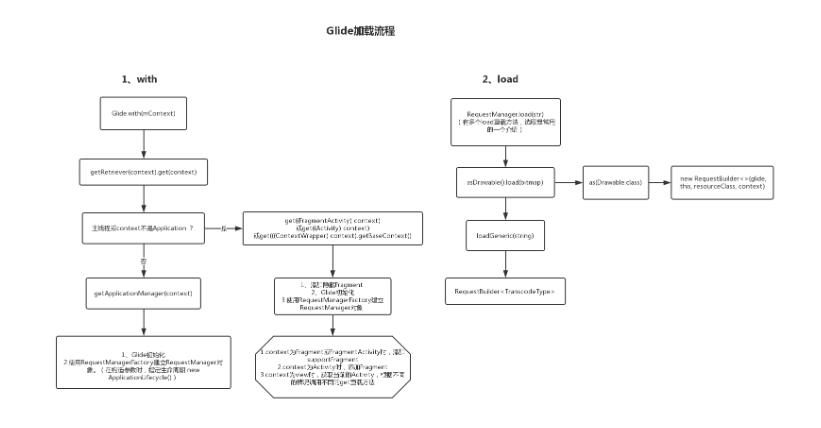
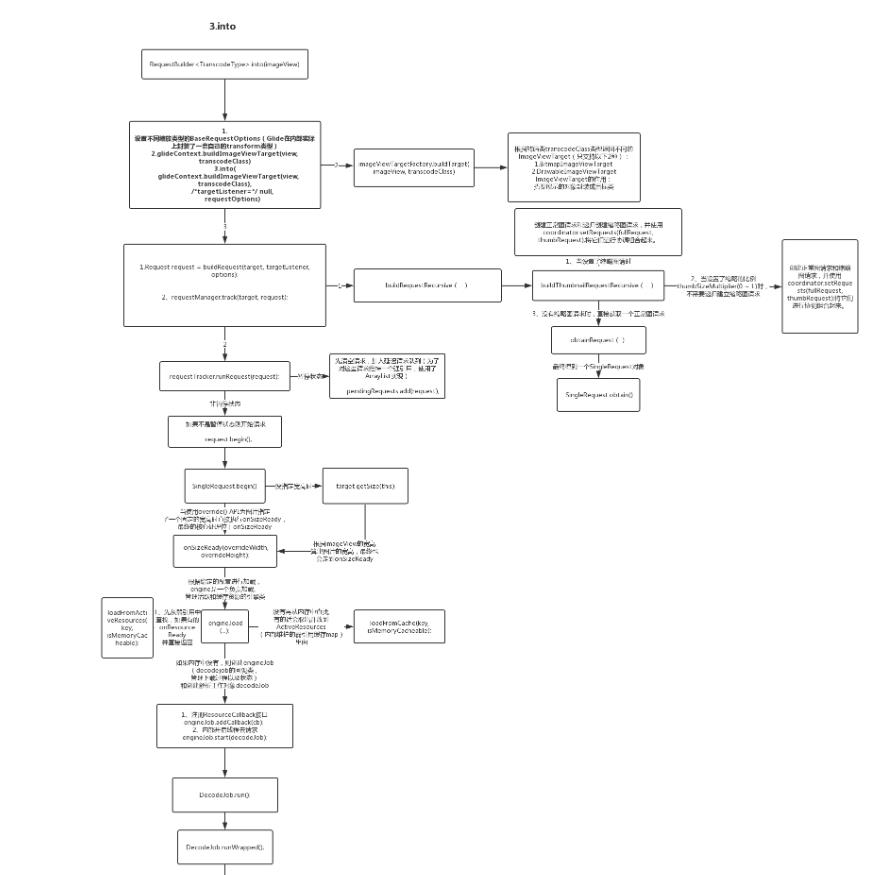
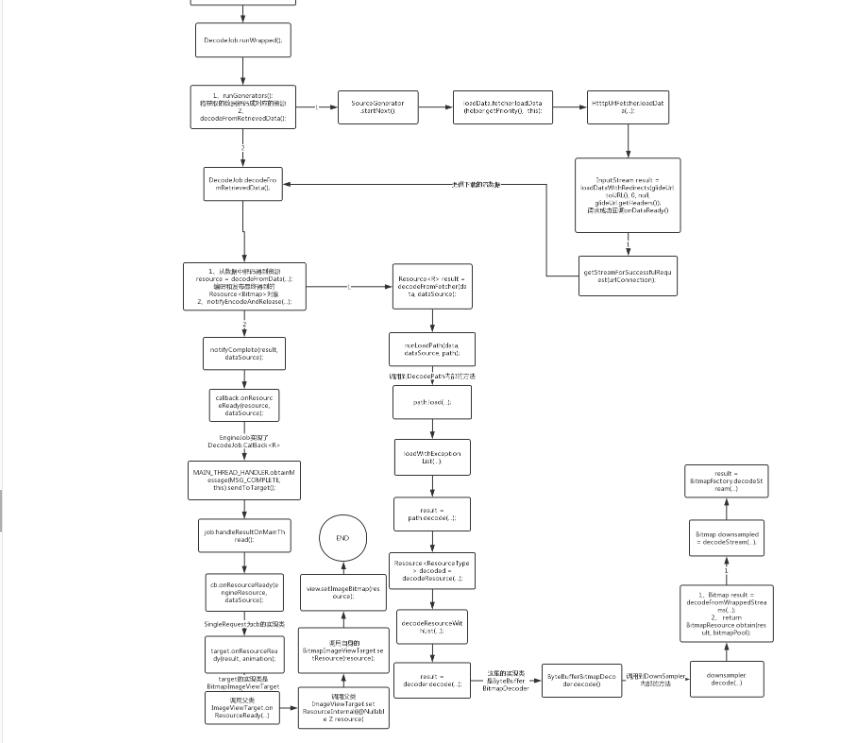
可以看到,Glide最核心的逻辑都聚集在into()方法中,它里面的设计精巧而复杂,这部分的源码分析非常耗时,但是,如果你真真正正地去一步步去深入其中,你也许在Android进阶之路上将会有顿悟的感觉。
四丶Dagger 2
1.预备知识
1.1.@Inject
告诉dagger这个字段或类需要依赖注入,然后在需要依赖的地方使用这个注解,dagger会自动生成这个构造器的实例。
获取所需依赖:
- 全局变量注入
- 方法注入
提供所需实例:
- 构造器注入(如果有多个构造函数,只能注解一个,否则编译报错)
1.2.@Module
类注解,表示此类的方法是提供依赖的,它告诉dagger在哪可以找到依赖。用于不能用@Inject提供依赖的地方,如第三方库提供的类,基本数据类型等不能修改源码的情况。
注意:Dagger2会优先在@Module注解的类上查找依赖,没有的情况才会去查询类的@Inject构造方法
1.3.@Singleton
声明这是一个单例,在确保只有一个Component并且不再重新build()之后,对象只会被初始化一次,之后的每次都会被注入相同的对象,它就是一个内置的作用域。
对于@Singleton,大家可能会产生一些误解,这里详细阐述下:
- Singleton容易给人造成一种误解就是用Singleton注解后在整个Java代码中都是单例,但实际上他和Scope一样,只是在同一个Component是单例。也就是说,如果重新调用了component的build()方法,即使使用了Singleton注解了,但仍然获取的是不同的对象。
- 它表明了**@Singleton注解只是声明了这是一个单例,为的只是提高代码可读性,其实真正控制对象生命周期的还是Component**。同理,自定义的@ActivityScope 、@ApplicationScope也仅仅是一个声明的作用,真正控制对象生命周期的还是Component。
1.4.@Providers
只在@Module中使用,用于提供构造好的实例。一般与@Singleton搭配,用单例方法的形式对外提供依赖,是一种替代@Inject注解构造方法的方式。
注意:
- 使用了@Providers的方法应使用provide作为前缀,使用了@Module的类应使用Module作为后缀。
- 如果@Providers方法或@Inject构造方法有参数,要保证它能够被dagger获取到,比如通过其它@Providers方法或者@Inject注解构造器的形式得到。
1.5.@Component
@Component作为Dagger2的容器总管,它拥有着@Inject与@Module的所有依赖。同时,它也是一枚注射器,用于获取所需依赖和提供所需依赖的桥梁。这里的桥梁即指@Inject和@Module(或@Inject构造方法)之间的桥梁。定义时需要列出响应的Module组成,此外,还可以使用dependencies继承父Component。
Component与Module的区别:
Component既是注射器也是一个容器总管,而module则是作为容器总管Component的子容器,实质是一个用于提供依赖的模块。
1.6.@Scope
注解作用域,通过自定义注解限定对象作用范围,增强可读性。
@Scope有两种常用的使用场景:
- 模拟Singleton代表全局单例,与Component生命周期关联。
- 模拟局部单例,如登录到退出登录期间。
1.7.@Qualifier
限定符,利用它定义注解类以用于区分类的不同实例。例如:2个方法返回不同的Person对象,比如说小明和小华,为了区分,使用@Qualifier定义的注解类。
dependencies
使用它表示ChildComponent依赖于FatherComponent,如下所示:
@Component(modules = ChildModule.class, dependencies = FatherComponent.class)
public interface ChildComponent
...
1.8.@SubComponent
表示是一个子@Component,它能将应用的不同部分封装起来,用来替代@Dependencies。
2.简单示例
2.1.首先,创建一个BaseActivityComponent的Subcomponent:
@Subcomponent(modules = AndroidInjectionModule.class)
public interface BaseActivityComponent extends AndroidInjector<BaseActivity>
@Subcomponent.Builder
abstract class BaseBuilder extends AndroidInjector.Builder<BaseActivity>
这里必须要注解成@Subcomponent.Builder表示是顶级@Subcomponent的内部类。AndroidInjector.Builder的泛型指定了BaseActivity,即表示每一个继承于BaseActivity的Activity都继承于同一个子组件(BaseActivityComponent)。
2.2.然后,创建一个将会导入Subcomponent的公有Module。
// 1
@Module(subcomponents = BaseActivityComponent.class)
public abstract class AbstractAllActivityModule
@ContributesAndroidInjector(modules = MainActivityModule.class)
abstract MainActivity contributesMainActivityInjector();
@ContributesAndroidInjector(modules = SplashActivityModule.class)
abstract SplashActivity contributesSplashActivityInjector();
// 一系列的对应Activity的contributesxxxActivityInjector
...
在注释1处用subcomponents来表示开放全部依赖给AbstractAllActivityModule,使用Subcomponent的重要原因是它将应用的不同部分封装起来了。@AppComponent负责维护共享的数据和对象,而不同处则由各自的@Subcomponent维护。
2.3.接着,配置项目的Application。
public class WanAndroidApp extends Application implements HasActivityInjector
// 3
@Inject
DispatchingAndroidInjector<Activity> mAndroidInjector;
private static volatile AppComponent appComponent;
@Override
public void onCreate()
super.onCreate();
...
// 1
appComponent = DaggerAppComponent.builder()
.build();
// 2
appComponent.inject(this);
...
...
// 4
@Override
public AndroidInjector<Activity> activityInjector()
return mAndroidInjector;
首先,在注释1处,使用AppModule模块和httpModule模块构建出AppComponent的实现类DaggerAppComponent。这里看一下AppComponent的配置代码:
@Singleton
@Component(modules = AndroidInjectionModule.class,
AndroidSupportInjectionModule.class,
AbstractAllActivityModule.class,
AbstractAllFragmentModule.class,
AbstractAllDialogFragmentModule.class
)
public interface AppComponent
/**
* 注入WanAndroidApp实例
*
* @param wanAndroidApp WanAndroidApp
*/
void inject(WanAndroidApp wanAndroidApp);以上是关于架构大合集,轻松应对工作需求(中)的主要内容,如果未能解决你的问题,请参考以下文章